
Last modification:
Streamlined forms are characterized by elongated, straight, low-elevation ridges, composed mostly of diamicton. This generic term encompasses several types of morphologies, including drumlins and drumlinoids. They are probably the most studied glacial morphology in recent decades. There are more than 1300 contributions (articles, abstracts or theses) in the literature, including more than 400 scientific papers published since 1980 (Menzies, 1984; Patterson and Hooke, 1995; Clark et al., 2009; Stokes et al., 2011; Spagnolo et al., 2012).
Etymology
The term drumlin is derived from the Irish word druim which means “back” or “rounded ridge”. These forms were recognized in glaciated terrains of Ireland and named by Close (1866). The name was subsequently used by various geological surveys undertaking the study and mapping of ice forms in Britain, Ireland (Kinahan, 1874; Kilroe, 1888) and North America (Davis, 1884; Upham, 1889; Tarr, 1894).

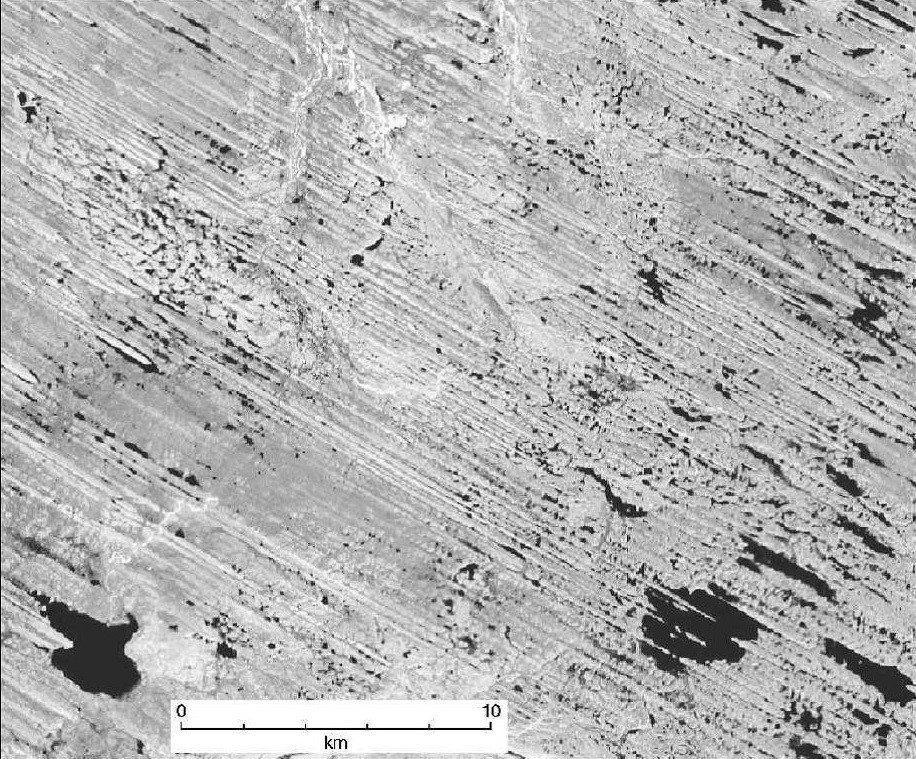 Drumlinoid is a term related to drumlins, but with less restrictive morphological criteria.
Drumlinoid is a term related to drumlins, but with less restrictive morphological criteria.
In English literature, the terms fluted moraines, flutings or streamed line ridges are the best equivalents for drumlinoids (Boulton, 1976; Rose, 1987; Benn and Evans, 2010). There is no consensus on the use of the different terms and the French equivalent of some terms is unclear. In the Ministère’s publications, the term drumlinoid is a general term for streamlined shapes larger than drumlins, thus encompassing any fluting shape, or the term Mega-Scale Glacial Lineation (MSGL). The drumlins themselves have a separate designation (DU) in the Quaternary legend, as do flutes (RGL).
Description
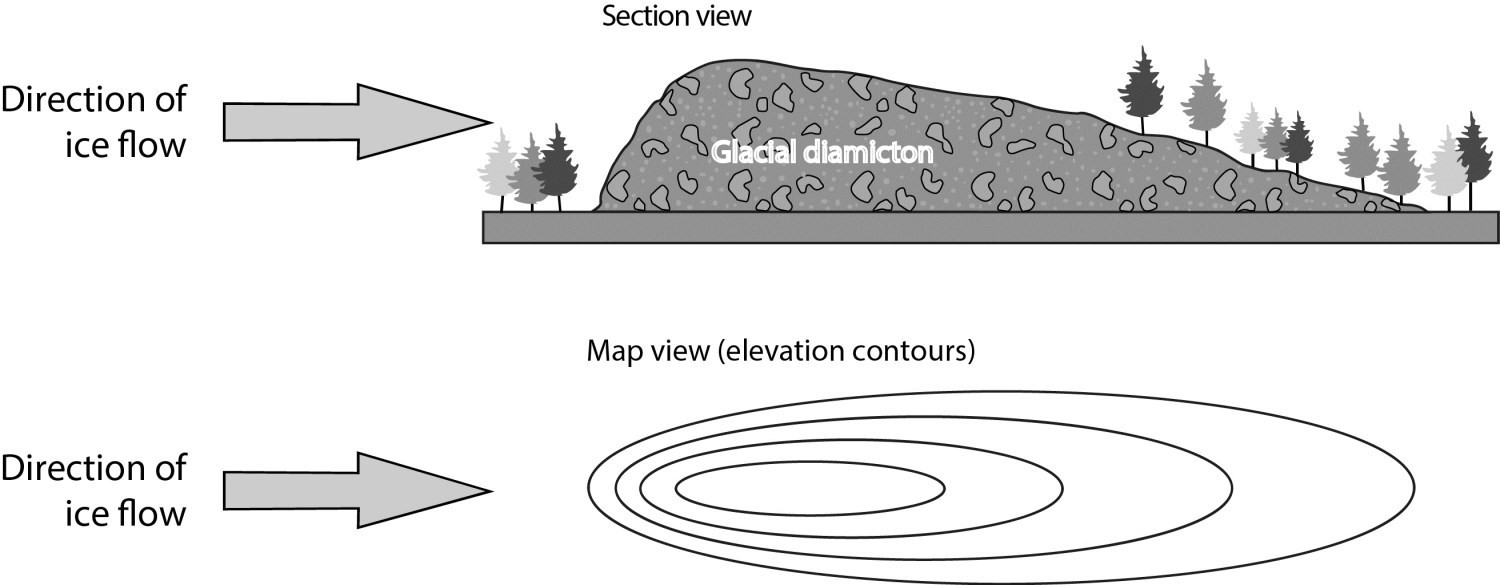
 A drumlin is a small, ellipsoidal, asymmetrically shaped mound characterized by a rounded apex side and a gently sloping streamlined side. The blunt apex is the highest point of elevation and is located at the glacial headwaters of the bedform while the streamlined side indicates the glacial flow direction (Benn and Evans, 2010).
A drumlin is a small, ellipsoidal, asymmetrically shaped mound characterized by a rounded apex side and a gently sloping streamlined side. The blunt apex is the highest point of elevation and is located at the glacial headwaters of the bedform while the streamlined side indicates the glacial flow direction (Benn and Evans, 2010).
Numerous studies have shown that their morphology can vary greatly (length, width, height, spacing, symmetry, wick or parabolic shape; Menzies, 1979; Coudé 1989; Mitchell, 1994; Smalley and Warburton, 1994; Benn and Evans, 2010). Analysis of clusters or swarms comprising tens of thousands of drumlins in Britain and Ireland led Clark et al. (2009) to establish mean morphometric parameters (lengths, widths and elongation ratios) of 629 m, 209 m and 2.9 respectively. In general, drumlins vary in length from 250 m to 1000 m, 120 m to 300 m in width and 0.5 m to 40 m in height (Clark et al., 2009; Spagnolo et al., 2012; Ely et al., 2018).
The elongation ratio, determined by the length of the shape in relation to its width, is generally below 3. Above this threshold, hectometric to kilometric shapes will generally be described as drumlinoid, and above 10, as mega-scale glacial lineations (MSGL; see Etymology; Stokes and Clark, 1999; 2002).
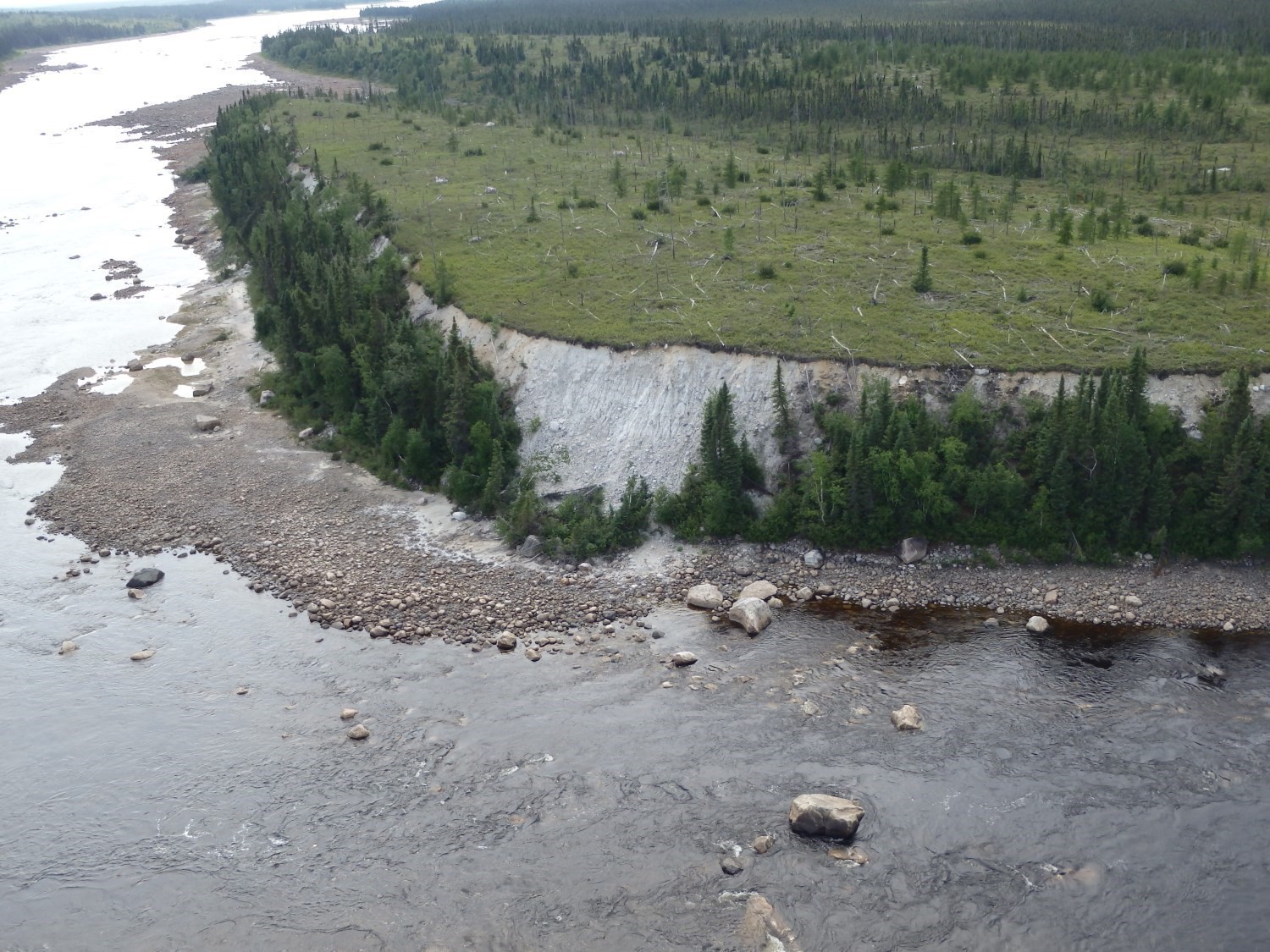

 Several studies have demonstrated that the composition of drumlins can vary greatly depending on the substrate. Drumlins are predominantly composed of glacial sediments, although some specimens have a rock core (Menzies, 1979; Patterson and Hooke, 1995). The majority of drumlins are composed entirely of glacial diamicton (Newman and Mickelson, 1994), but may also be composed of a core of sorted material with a till shell on the surface (Hart, 1994; 1995). The sedimentary characteristics of sediments beneath the till may be evidence of a deposition which is earlier (Krüger and Thomsen, 1984; Boulton 1987; Boyce and Eyles, 1991; Menzies and Brand, 2007; Benn and Evans, 2010) or contemporaneous with the formation of streamlined shapes (Dardis and McCabe 1983; 1987; Dardis, 1985; McCabe and Dardis, 1989; Shaw, 1989; Benn and Evans, 2010; Evans et al., 2015). Some studies also mention the presence of glaciotectonic deformations in sediments during the drumlin formation process (upturned folds, faults and water escape structures) (Bluemle and Clayton, 1984; Stanford and Mickelson, 1985; Boulton and Hindmarsh, 1987; Hart, 1995; 1997; Stokes et al., 2011; Hermanowski et al., 2019).
Several studies have demonstrated that the composition of drumlins can vary greatly depending on the substrate. Drumlins are predominantly composed of glacial sediments, although some specimens have a rock core (Menzies, 1979; Patterson and Hooke, 1995). The majority of drumlins are composed entirely of glacial diamicton (Newman and Mickelson, 1994), but may also be composed of a core of sorted material with a till shell on the surface (Hart, 1994; 1995). The sedimentary characteristics of sediments beneath the till may be evidence of a deposition which is earlier (Krüger and Thomsen, 1984; Boulton 1987; Boyce and Eyles, 1991; Menzies and Brand, 2007; Benn and Evans, 2010) or contemporaneous with the formation of streamlined shapes (Dardis and McCabe 1983; 1987; Dardis, 1985; McCabe and Dardis, 1989; Shaw, 1989; Benn and Evans, 2010; Evans et al., 2015). Some studies also mention the presence of glaciotectonic deformations in sediments during the drumlin formation process (upturned folds, faults and water escape structures) (Bluemle and Clayton, 1984; Stanford and Mickelson, 1985; Boulton and Hindmarsh, 1987; Hart, 1995; 1997; Stokes et al., 2011; Hermanowski et al., 2019).
 Crag & tails develop downstream of an obstacle, commonly a rocky knoll. The orientation of the tail indicates the ice flow direction. According to the legend used by Géologie Québec, these structures are mapped independently of drumlins and drumlinoids (TMF).
Crag & tails develop downstream of an obstacle, commonly a rocky knoll. The orientation of the tail indicates the ice flow direction. According to the legend used by Géologie Québec, these structures are mapped independently of drumlins and drumlinoids (TMF).
Genesis
Over the past few decades, many hypotheses, ideas or conceptual models have been proposed on the mechanism of drumlin formation without a clear consensus within the scientific community (Hall, 1815; Davis, 1884; Boulton, 1976; Menzies, 1979; 1987; Rose, 1987; Shaw, 2002; Stokes et al., 2013). The debate on the origin of drumlins is ongoing and somewhat controversial (Schomaker et al., 2018). The main models suggested in numerous studies imply the formation of drumlins by erosion processes, deposition, or by the theory of environmental instability.
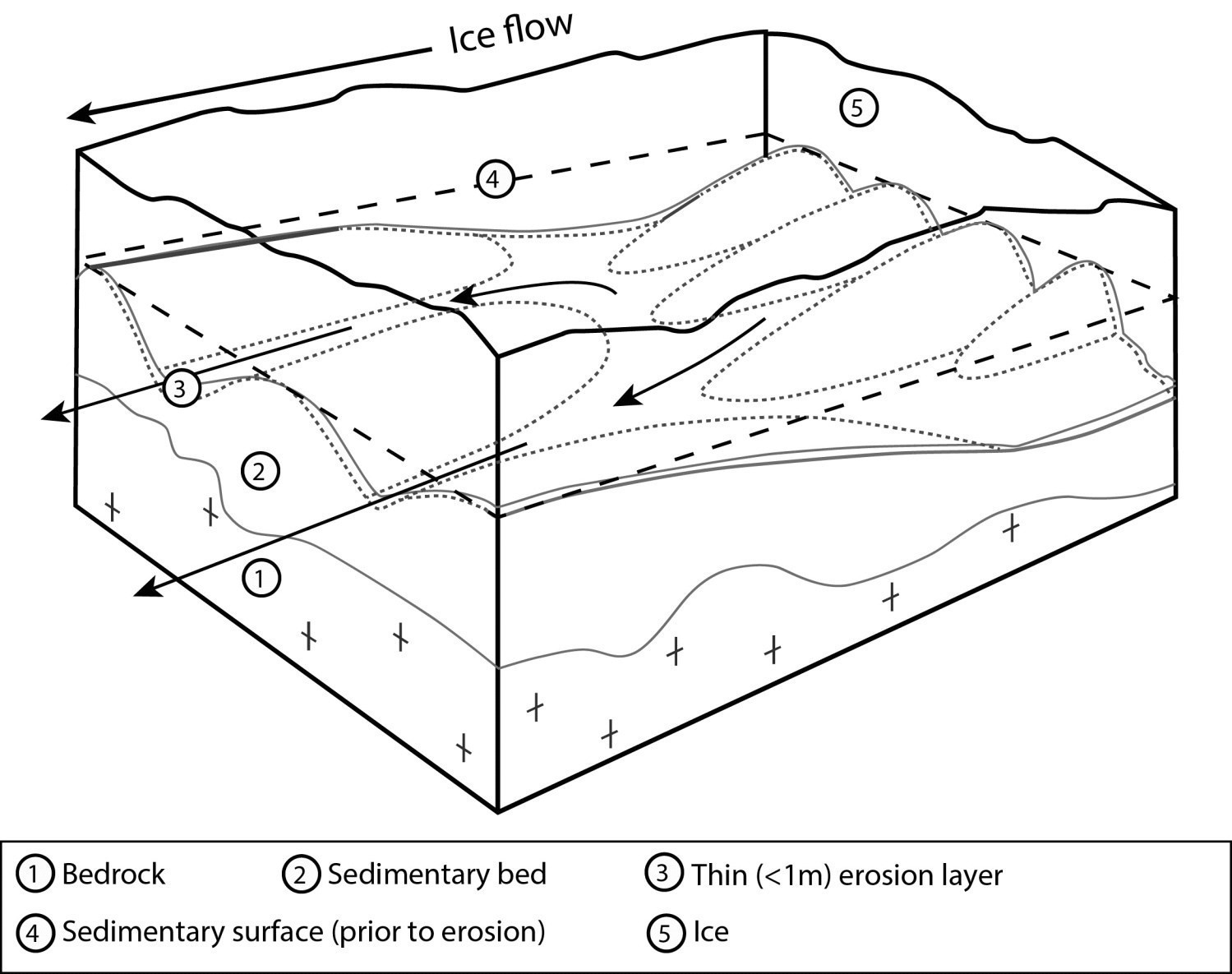 The erosional model is explained by differential erosion of pre-existing diamictic, fluvioglacial or bedrock material from the top to the bottom of the glacier, leading to the individualization of drumlins (Menzies, 1979; Boulton, 1987; Hart and Boulton, 1991; Hart, 1995; 1997; Knight; 2010; Eyles et al., 2016). One branch of this model, the subglacial catastrophic flood hypothesis as the origin of drumlin formation (Shaw, 1983; 1989; 1996; 2002; 2007; Shaw et al., 1989; Shoemaker, 1992; Rains et al., 1993), has been contested since its inception in the 1980s (Kehew et al., 1990; Forsström and Shaw, 1990; Clarke et al., 2004; 2005; Sharpe et al., 2005; Evans et al., 2006; Benn et al., 2007; Evans; 2010; Ó Cofaigh et al., 2010; Shaw, 2010a; 2010b; Shaw and Young 2010).
The erosional model is explained by differential erosion of pre-existing diamictic, fluvioglacial or bedrock material from the top to the bottom of the glacier, leading to the individualization of drumlins (Menzies, 1979; Boulton, 1987; Hart and Boulton, 1991; Hart, 1995; 1997; Knight; 2010; Eyles et al., 2016). One branch of this model, the subglacial catastrophic flood hypothesis as the origin of drumlin formation (Shaw, 1983; 1989; 1996; 2002; 2007; Shaw et al., 1989; Shoemaker, 1992; Rains et al., 1993), has been contested since its inception in the 1980s (Kehew et al., 1990; Forsström and Shaw, 1990; Clarke et al., 2004; 2005; Sharpe et al., 2005; Evans et al., 2006; Benn et al., 2007; Evans; 2010; Ó Cofaigh et al., 2010; Shaw, 2010a; 2010b; Shaw and Young 2010).
Drumlins could also form by deposition of loose sediment downstream of an obstacle (rocky hummock, consolidated till, competent sediment; Fairchild, 1929; Boulton, 1987; Menzies et al., 2016), or by continuous sedimentary accretion to the tail of the streamlined bedform (Dardis and McCabe, 1983; Dardis et al., 1984; Hart and Boulton, 1991; Dardis and Hanvey, 1994; Patterson and Hooke, 1995; Fowler, 2009; Knight, 2010; Barchyn et al., 2016; Hart et al., 2018). In contrast to the erosional model, drumlin formation in this case would be by vertical accretion and therefore “bottom-up” (Eyles et al., 2016).
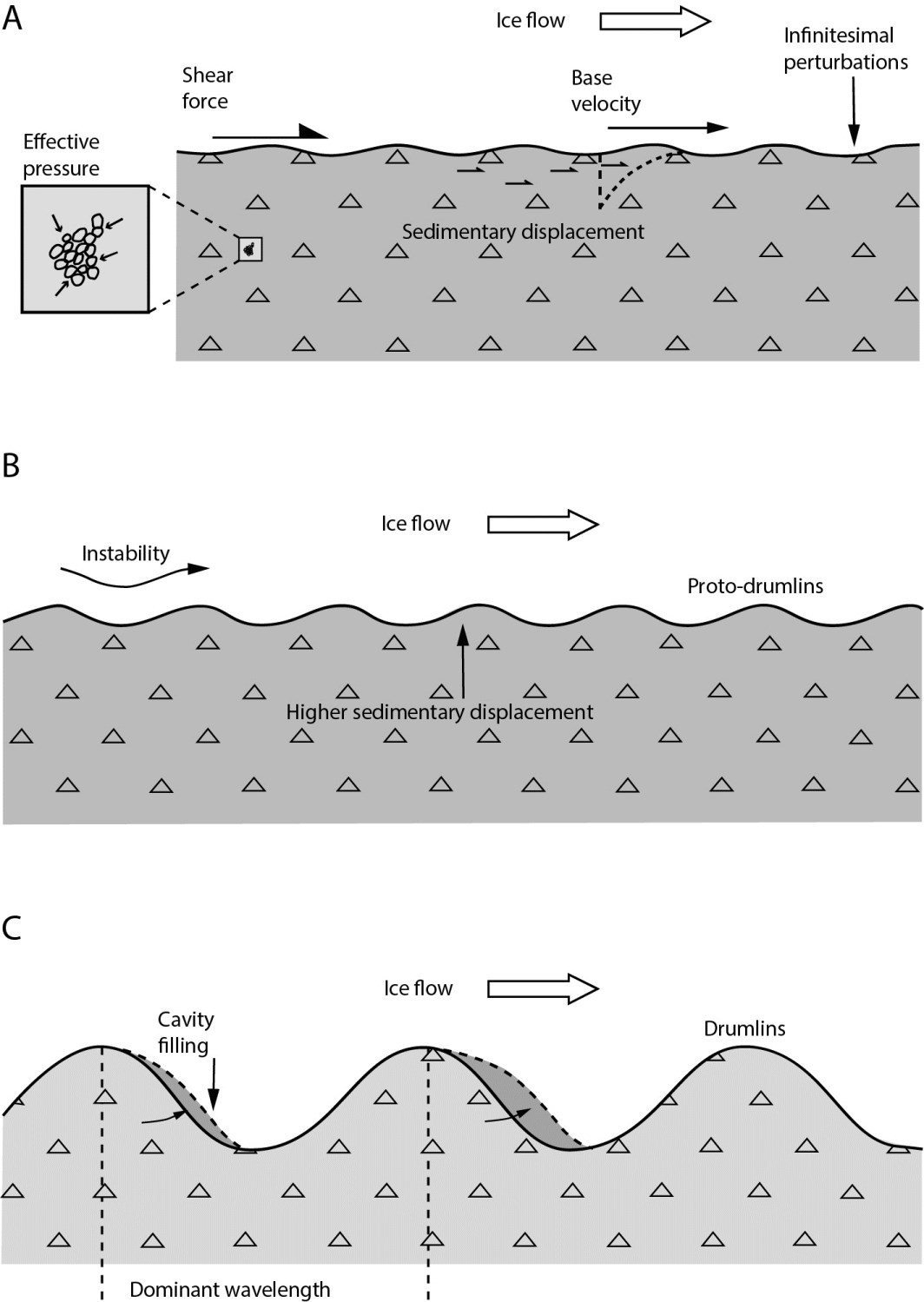 The theory of environmental instability to explain the formation of drumlins and other subglacial bedforms was introduced in the 1990s (Patterson and Hooke, 1995; Hindmarsh 1996; 1998; 1999; Fowler, 2000; 2009; Schoof, 2007; Dunlop et al., 2008; Clark et al., 2009; 2018; Clark, 2010; Stokes et al., 2011; 2013; Spagnolo et al., 2012; Fowler et al., 2013; Hillier et al., 2013; 2018; Eyles et al., 2016). This theory predicts that slight variations in local relief (instability) are sufficient to induce a positive feedback loop in erosion and deposition processes. Through this loop, the instability of the medium increases exponentially until a specific wavelength is reached, resulting in the formation of a multitude of shapes with similar morphology and spacing. This mechanism is commonly observed in the organization of aeolian and fluvial sediments, for example in the repetitive undulations of ripples on a sandy beach. In a subglacial context, the variation in basal ice conditions generates a rheological instability which is large enough to cause deformation of the water-saturated diamictic substrate, and the subsequent formation of subglacial bedforms, particularly streamlined forms.
The theory of environmental instability to explain the formation of drumlins and other subglacial bedforms was introduced in the 1990s (Patterson and Hooke, 1995; Hindmarsh 1996; 1998; 1999; Fowler, 2000; 2009; Schoof, 2007; Dunlop et al., 2008; Clark et al., 2009; 2018; Clark, 2010; Stokes et al., 2011; 2013; Spagnolo et al., 2012; Fowler et al., 2013; Hillier et al., 2013; 2018; Eyles et al., 2016). This theory predicts that slight variations in local relief (instability) are sufficient to induce a positive feedback loop in erosion and deposition processes. Through this loop, the instability of the medium increases exponentially until a specific wavelength is reached, resulting in the formation of a multitude of shapes with similar morphology and spacing. This mechanism is commonly observed in the organization of aeolian and fluvial sediments, for example in the repetitive undulations of ripples on a sandy beach. In a subglacial context, the variation in basal ice conditions generates a rheological instability which is large enough to cause deformation of the water-saturated diamictic substrate, and the subsequent formation of subglacial bedforms, particularly streamlined forms.
Spatial Distribution

 Drumlins are a ubiquitous landform found in most areas that were glaciated during the last ice age (Flint 1971; Embleton and King 1975; Menzies 1979; 1984; Clark et al., 2009). They are often grouped in fields that may reach several thousand (Benn and Evans, 2010). In North America, the largest drumlin swarms are in New York (10 000), New England (3000), Wisconsin (5000) and Nova Scotia (2300; Menzies, 1979).
Drumlins are a ubiquitous landform found in most areas that were glaciated during the last ice age (Flint 1971; Embleton and King 1975; Menzies 1979; 1984; Clark et al., 2009). They are often grouped in fields that may reach several thousand (Benn and Evans, 2010). In North America, the largest drumlin swarms are in New York (10 000), New England (3000), Wisconsin (5000) and Nova Scotia (2300; Menzies, 1979).
Fields of streamlined bedforms are generally formed in depressional areas, in this case in lowlands and valleys, where subglacial basal stress is low, pore water pressure is high and sediment occurrence is high (Mitchell, 1994; Kovanen and Slaymaker, 2004; Mitchell and Riley, 2006). However, streamlined bedforms are not only confined to topographic depressions. Indeed, their presence has also been described on some plateaus, indicating an emplacement which is independent of topographic controls (Patterson and Hooke, 1995). As opposed to what has been previously suggested (Smalley and Unwin, 1968; Francek, 1991), recent studies tend to indicate that the distribution of drumlins is rarely random within fields and that they are emplaced at regular intervals between 100 m and 1200 m (Fowler, 2000; Clark, 2010; Clark et al., 2018). Finally, the nature and properties of the substrate also play a role in their distribution (Menzies, 1979; Boulton, 1987; Patterson and Hooke, 1995).
Because of their uniformity of characteristics within the same field (similar orientation, proximity and plurality of shapes, similar morphologies, etc.), groupings of streamlined bedforms are generally used to define flow-sets (Clark, 1994; 1999; Clark et al., 2000). These fields tend to appear in proximity (~80 km) to the ice margin (Patterson and Hooke, 1995); thus, the study of their distribution is essential for understanding and reconstructing the dynamics of former ice sheets (Clark et al., 2000).
References
Other Publications
BARCHYN, T.E., DOWLING, T.P.F., STOKES, C.R., HUGENHOLTZ, C.H., 2016. Subglacial bed form morphology controlled by ice speed and sediment thickness. Geophysical Research Letters; volume 43, pages 7572–7580. doi.org/10.1002/2016GL069558
BENN, D.I., EVANS, D.J.A., 2010., Glaciers and glaciations, second edition. Routledge, Taylor & Francis Group, London and New York, 802 pages. doi.org/10.4324/9780203785010
BENN, D.I., EVANS, D.J.A., SHAW, J., MUNRO-STASIUK, M., 2007. Subglacial Megafloods: Outrageous Hypothesis or Just Outrageous? In Glacier Science and Environmental Change, John Wiley & Sons, pages 42–50. doi.org/10.1002/9780470750636.ch8
BLUEMLE, J.P., CLAYTON, L., 1984. Large‐scale glacial thrusting and related processes in North Dakota. Boreas; volume 13, pages 279–299. doi.org/10.1111/j.1502-3885.1984.tb01124.x
BOULTON, G.S., 1976. The origin of glacially fluted surfaces-observations and theory. Journal of Glaciology; volume 17, pages 287–309. doi.org/10.3189/S0022143000013605
BOULTON, G.S., 1987. A theory of drumlin formation by subglacial sediment deformation. In Menzies, J. et Rose, J. (eds), Drumlin Symposium 1987, Balkema, Rotterdam, pages 25–80.
BOULTON, G.S., HINDMARSH, R.C.A., 1987. Sediment deformation beneath glaciers: Rheology and geological consequences. Journal of Geophysical Research; volume 92, pages 9059–9082. doi.org/10.1029/JB092iB09p09059
BOYCE, J.I., EYLES, N., 1991. Drumlins carved by deforming till streams below the Laurentide Ice Sheet. Geology; volume 19, pages 787–790. doi.org/10.1130/0091-7613(1991)019<0787:DCBDTS>2.3.CO;2
CLARK, C.D., 1994. Large-scale ice-moulding: a discussion of genesis and glaciological significance. Sedimentary Geology; volume 91, pages 253–268. doi.org/10.1016/0037-0738(94)90133-3
CLARK, C.D., 1999. Glaciodynamic context of subglacial bedform generation and preservation. Annals of Glaciology; volume 28, pages 23–32. doi.org/10.3189/172756499781821832
CLARK, C.D., 2010. Emergent drumlins and their clones: From till dilatancy to flow instabilities. Journal of Glaciology; volume 56, pages 1011–1025. doi.org/10.3189/002214311796406068
CLARK, C.D., ELY, J.C., SPAGNOLO, M., HAHN, U., HUGHES, A.L.C., STOKES, C.R., 2018. Spatial organization of drumlins. Earth Surface Processes and Landforms; volume 43, pages 499–513. doi.org/10.1002/esp.4192
CLARK, C.D., HUGHES, A.L.C., GREENWOOD, S.L., SPAGNOLO, M.S., NG, F.S.L., 2009. Size and shape characteristics of drumlins, derived from a large sample, and associated scaling laws. Quaternary Science Reviews; volume 28, pages 677–692. doi.org/10.1016/j.quascirev.2008.08.035
CLARK, C.D., KNIGHT, J.K., GRAY, J.T., 2000. Geomorphological reconstruction of the Labrador Sector of the Laurentide Ice Sheet. Quaternary Science Reviews; volume 19, pages 1343–1366. doi.org/10.1016/S0277-3791(99)00098-0
CLARK, C.D., TULACZYK, S.M., STOKES, C.R., CANALS, M., 2003. A groove-ploughing theory for the production of mega-scale glacial lineations, and implications for ice-stream mechanics. Journal of Glaciology; volume 49, pages 240–256. doi.org/10.3189/172756503781830719
CLARKE, G.K.C., LEVERINGTON, D.W., TELLER, J.T., DYKE, A.S., 2004. Paleohydraulics of the last outburst flood from glacial Lake Agassiz and the 8200BP cold event. Quaternary Science Reviews; volume 23, pages 389–407. doi.org/10.1016/j.quascirev.2003.06.004
CLARKE, G.K.C., LEVERINGTON, D.W., TELLER, J.T., DYKE, A.S., MARSHALL, S.J., 2005. Fresh arguments against the Shaw megaflood hypothesis. A reply to comments by David Sharpe on “Paleohydraulics of the last outburst flood from glacial Lake Agassiz and the 8200 BP cold event”. Quaternary Science Reviews; volume 24, pages 1533–1541. doi.org/10.1016/j.quascirev.2004.12.003
CLOSE, M.H., 1866. Notes on the general glaciation of Ireland. Journal of the Geological Society of Ireland; volume 1, pages 207–242. Source
COUDÉ, A., 1989. Comparative study of three drumlin fields in western Ireland: geomorphological data and genetic implications. Sedimentary Geology; volume 62, pages 321–335. doi.org/10.1016/0037-0738(89)90122-X
DARDIS, G.F., 1985. Till facies associations in drumlins and some implications for their mode of formation. Geografiska Annaler, Series A; volume 67A, pages 13–22. doi.org/10.1080/04353676.1985.11880126
DARDIS, G.F., HANVEY, P.M., 1994. Sedimentation in a drumlin lee-side subglacial wave cavity, northwest Ireland. Sedimentary Geology; volume 91, pages 97–114. doi.org/10.1016/0037-0738(94)90124-4
DARDIS, G.F., MCCABE, A.M., 1983. Fades of subglacial channel sedimentation in late‐Pleistocene drumlins, Northern Ireland. Boreas; volume 12, pages 263–278. doi.org/10.1111/j.1502-3885.1983.tb00321.x
DARDIS, G.F., MCCABE, A.M., 1987. Subglacial sheetwash and debris flow deposits in late-Pleistocene drumlins, Northern Ireland. In Menzies, J. et Rose, J. (eds), Drumlin Symposium 1987, Balkema, Rotterdam, pages 225–240.
DARDIS, G.F., MCCABE, A.M., MITCHELL, W.I., 1984. Characteristics and origins of lee‐side stratification sequences in late pleistocene drumlins, northern Ireland. Earth Surface Processes and Landforms; volume 9, pages 409–424. doi.org/10.1002/esp.3290090503
DAVIS, W.M., 1884. ART. XLVIII–The distribution and origin of drumlins. American Journal of Science; volume 28, 407 pages.
DUNLOP, P., CLARK, C.D., HINDMARSH, R.C.A., 2008. Bed ribbing instability explanation: Testing a numerical model of ribbed moraine formation arising from couple flow of ice and subglacial sediment. Journal of Geophysical Research: Earth Surface; volume 113, pages 1–15. doi.org/10.1029/2007JF000954
ELY, J.C., CLARK, C.D., SPAGNOLO, M., HUGHES, A.L.C., STOKES, C.R., 2018. Using the size and position of drumlins to understand how they grow, interact and evolve. Earth Surface Processes and Landforms; volume 43, pages 1073‑1087. doi.org/10.1002/esp.4241
EMBLETON, C., KING, C.A.M., 1975. Glacial and periglacial geomorphology. 2ème edition, Edward Arnold, Londres, 573 pages.
EVANS, D.J.A., 2010. Defending and testing hypotheses: A response to John Shaw’s paper ‘In defence of the meltwater (megaflood) hypothesis for the formation of subglacial bedform fields’. Journal of Quaternary Science; volume 25, pages 822‑823. doi.org/10.1002/jqs.1371
EVANS, D.J.A., REA, B.R., HIEMSTRA, J.F., Ó COFAIGH, C., 2006. A critical assessment of subglacial mega-floods: a case study of glacial sediments and landforms in south-central Alberta, Canada. Quaternary Science Reviews; volume 25, pages 1638–1667. doi.org/10.1016/j.quascirev.2005.12.007
EVANS, D.J.A., ROBERTS, D.H., Ó COFAIGH, C., 2015. Drumlin sedimentology in a hard-bed, lowland setting, Connemara, western Ireland: Implications for subglacial bedform generation in areas of sparse till cover. Journal of Quaternary Science; volume 30, pages 537–557. doi.org/10.1002/jqs.2801
EYLES, N., PUTKINEN, N., SOOKHAN, S., ARBELAEZ-MORENO, L., 2016. Erosional origin of drumlins and megaridges. Sedimentary Geology; volume 338, pages 2–23. doi.org/10.1016/j.sedgeo.2016.01.006
FAIRCHILD, H.I., 1929. New York Drumlins. Proceedings of the Rochester Academy of Science; volume 7, pages 1‑37.
FLINT, R.F., 1971. Glacial and Quaternary geology. John Wiley & Sons, Inc., 892 pages.
FORSSTRÖM, L., SHAW, J., 1990. Comment and Reply on ‘Drumlins, subglacial meltwater floods, and ocean responses’. Geology; volume 18, pages 804–805. doi.org/10.1130/0091-7613(1990)018<0804:CARODS>2.3.CO;2
FOWLER, A.C., 2000. An instability mechanism for drumlin formation. Geological Society Special Publication; volume 176, pages 307–319. doi.org/10.1144/GSL.SP.2000.176.01.23
FOWLER, A.C., 2009. Instability modelling of drumlin formation incorporating lee-side cavity growth. Proceedings of the Royal Society A: Mathematical, Physical and Engineering Sciences; volume 465, pages 2681–2702. doi.org/10.1098/rspa.2008.0490
FOWLER, A.C., 2010. The instability theory of drumlin formation applied to Newtonian viscous ice of finite depth. Proceedings of the Royal Society A: Mathematical, Physical and Engineering Sciences; volume 466, pages 2673–2694. doi.org/10.1098/rspa.2010.0017
FOWLER, A.C., 2018. The philosopher in the kitchen: the role of mathematical modelling in explaining drumlin formation. Geologiska Föreningens i Stockholm Förhandlingar; volume 140, pages 93–105. doi.org/10.1080/11035897.2018.1444671
FOWLER, A.C., SPAGNOLO, M., CLARK, C.D., STOKES, C.R., HUGHES, A.L.C., DUNLOP, P., 2013. On the size and shape of drumlins. GEM: International Journal on Geomathematics; volume 4, pages 155–165. doi.org/10.1007/s13137-013-0050-0
FRANCEK, M.A., 1991. A spatial perspective on the New York drumlin field. Physical Geography; volume 12, pages 1–18. doi.org/10.1080/02723646.1991.10642415
HALL, J., 1815. IV. On the Revolutions of the Earth’s Surface. Transactions of the Royal Society of Edinburgh; volume 7, pages 139–167. doi.org/10.1017/S0080456800019281
HART, J.K., 1994. Till fabric associated with deformable beds. Earth Surface Processes and Landforms; volume 19, pages 15–32. doi.org/10.1002/esp.3290190103
HART, J.K., 1995. Subglacial erosion, deposition and deformation associated with deformable beds. Progress in Physical Geography; volume 19, pages 173–191. doi.org/10.1177/030913339501900202
HART, J.K., 1997. The relationship between drumlins and other forms of subglacial glaciotectonic deformation. Quaternary Science Reviews; volume 16, pages 93–107. doi.org/10.1016/S0277-3791(96)00023-6
HART, J.K., BOULTON, G.S., 1991. The interrelation of glaciotectonic and glaciodepositional processes within the glacial environment. Quaternary Science Reviews; volume 10, pages 335–350. doi.org/10.1016/0277-3791(91)90035-S
HART, J.K., CLAYTON, A.I., MARTINEZ, K., ROBSON, B.A., 2018. Erosional and depositional subglacial streamlining processes at Skálafellsjökull, Iceland: an analogue for a new bedform continuum model. Geologiska Föreningens i Stockholm Förhandlingar; volume 140, pages 153–169. doi.org/10.1080/11035897.2018.1477830
HERMANOWSKI, P., PIOTROWSKI, J.A., SZUMAN, I., 2019. An erosional origin for drumlins of NW Poland. Earth Surface Processes and Landforms; volume 44, pages 2030–2050. doi.org/10.1002/esp.4630
HILLIER, J.K., BENEDIKTSSON, Í.Ö., DOWLING, T.P.F., SCHOMACKER, A., 2018. Production and preservation of the smallest drumlins. Geologiska Föreningens i Stockholm Förhandlingar; volume 140, pages 136–152. doi.org/10.1080/11035897.2018.1457714
HILLIER, J.K., SMITH, M.J., CLARK, C.D., STOKES, C.R., SPAGNOLO, M., 2013. Subglacial bedforms reveal an exponential size-frequency distribution. Geomorphology; volume 190, pages 82–91. doi.org/10.1016/j.geomorph.2013.02.017
HINDMARSH, R.C.A., 1996. Sliding of till over bedrock: Scratching, polishing, comminution and kinematic-wave theory. Annals of Glaciology; volume 22, pages 41–47. doi.org/10.3189/1996AoG22-1-41-47
HINDMARSH, R.C.A., 1998. Drumlinization and drumlin-forming instabilities: viscous till mechanisms. Journal of Glaciology; volume 44, pages 293–314. doi.org/10.3189/S002214300000263X
HINDMARSH, R.C.A., 1999. Coupled ice-till dynamics and the seeding of drumlins and bedrock forms. Annals of Glaciology; volume 28, pages 221–230. doi.org/10.3189/172756499781821931
KEHEW, A.E., LORD, M.L., SHAW, J., 1990. Comment and Reply on ‘Drumlins, subglacial meltwater floods, and ocean responses’. Geology; volume 18, pages 479–480. doi.org/10.1130/0091-7613(1990)018<0479:CARODS>2.3.CO;2
KILROE, J.R., 1888. Directions of ice-flow in the north of Ireland, as determined by the observations of the geological survey. Quarterly Journal of the Geological Society of London; volume 44, pages 827-833. doi.org/10.1144/GSL.JGS.1888.044.01-04.53
KINAHAN, G.H., 1874. V.- Glacialoid or re-arranged glacial drift. Geological Magazine; volume 1, pages 168–174. doi.org/10.1017/S0016756800169316
KNIGHT, J., 2010. Drumlins and the dynamics of the subglacial environment. Sedimentary Geology; volume 232, pages 91-97. doi.org/10.1016/j.sedgeo.2010.10.001
KOVANEN, D.J., SLAYMAKER, O., 2004. Glacial imprints of the Okanogan Lobe, southern margin of the Cordilleran Ice Sheet. Journal of Quaternary Science; volume 19, pages 547–565. doi.org/10.1002/jqs.855
KRÜGER, J., THOMSEN, H.H., 1984. Morphology, stratigraphy, and genesis of small drumlins in front of the glacier Myrdalsjokull, south Iceland. Journal of Glaciology; volume 30, pages 94–105. doi.org/10.3189/S0022143000008534
MCCABE, A.M., DARDIS, G.F., 1989. Sedimentology and depositional setting of Late Pleistocene drumlins, Galway Bay, western Ireland. Journal of Sedimentary Petrology; volume 59, pages 944–959. doi.org/10.1306/212F90C0-2B24-11D7-8648000102C1865D
MENZIES, J., 1979. A review of the literature on the formation and location of drumlins. Earth Science Reviews; volume 14, pages 315-359. doi.org/10.1016/0012-8252(79)90093-X
MENZIES, J., 1984. Drumlins: a bibliography. Geo Books, Norwich; Geo Abstracts Bibliography 15. 117 pages.
MENZIES, J., 1987. Towards a general hypothesis on the formation of drumlins. In Menzies, J. et Rose, J. (eds), Drumlin Symposium 1987, Balkema, Rotterdam, pages 9–24.
MENZIES, J., BRAND, U., 2007. The internal sediment architecture of a drumlin, Port Byron, New York State, USA. Quaternary Science Reviews; volume 26, pages 322–335. doi.org/10.1016/j.quascirev.2006.07.003
MITCHELL, W.A., RILEY, J.M., 2006. Drumlin map of the Western Pennines and southern Vale of Eden, Northern England, UK. Journal of Maps; volume 2, pages 10–16. doi.org/10.4113/jom.2006.45
MITCHELL, W.A., 1994. Drumlins in ice sheet reconstructions, with reference to the western Pennines, northern England. Sedimentary Geology; volume 91, pages 313‑331. doi.org/10.1016/0037-0738(94)90137-6
NEWMAN, W.A., MICKELSON, D.M., 1994 – Genesis of Boston Harbor drumlins, Massachusetts. Sedimentary Geology; volume 91, pages 333–343. doi.org/10.1016/0037-0738(94)90138-4
NSIDC, 2020. Glacier Landforms: Drumlins. National Snow and Ice Data Center; page web visitée le 2 octobre 2020. Source
Ó COFAIGH, C., DOWDESWELL, J.A., KING, E.C., ANDERSON, J.B., CLARK, C.D., EVANS, D.J.A., EVANS, J., HINDMARSH, R.C.A., LARTER, R.D., STOKES, C.R., 2010. Comment on Shaw J., Pugin, A. and Young, R. (2008): ‘A meltwater origin for Antarctic shelf bedforms with special attention to megalineations’, Geomorphology; volume 102, pages 364-375. doi.org/10.1016/j.geomorph.2009.09.036
PATTERSON, C.J., HOOKE, R.L.B., 1995. Physical environment of drumlin formation. Journal of Glaciology; volume 41, pages 30–38. doi.org/10.3189/S0022143000017731
RAINS, B., SHAW, J., SKOYE, R., SJOGREN, D., KVILL, D., 1993. Late Wisconsin subglacial megaflood paths in Alberta. Geology; volume 21, pages 323‑326. doi.org/10.1130/0091-7613(1993)021<0323:LWSMPI>2.3.CO;2
ROSE, J., 1987. Drumlins as part of a glacier bedform continuum. In Menzies, J. et Rose, J. (eds), Drumlin Symposium 1987, Balkema, Rotterdam, pages 103–116.
SCHOMACKER, A., JOHNSON, M.D., MÖLLER, P., 2018. Drumlin formation: a mystery or not? Geologiska Föreningens i Stockholm Förhandlingar; volume 140, pages 91–92. doi.org/10.1080/11035897.2018.1485326
SCHOOF, C., 2007a. Cavitation on deformable glacier beds. SIAM Journal on Applied Mathematics; volume 67, pages 1633–1653. doi.org/10.1137/050646470
SCHOOF, C., 2007b. Pressure-dependent viscosity and interfacial instability in coupled ice-sediment flow. Journal of Fluid Mechanics; volume 570, pages 227–252. doi.org/10.1017/S0022112006002874
SHARPE, D.R., CLARKE, G.K.C., LEVERINGTON, D.W., TELLER, J.T., DYKE, A.S., MARSHALL, S.J., 2005. Comments on: ‘Paleohydraulics of the last outburst flood from glacial Lake Agassiz and the 8200 BP cold event’. Quaternary Science Reviews; volume 24, pages 1529–1532. doi.org/10.1016/j.quascirev.2005.01.004
SHAW, J., 1983. Drumlin formation related to inverted melt-water erosional marks. Journal of Glaciology; volume 29, pages 461–479. doi.org/10.3189/S0022143000030367
SHAW, J., 1989. Drumlins, subglacial meltwater floods, and ocean responses. Geology; volume 17, pages 853–856. doi.org/10.1130/0091-7613(1989)017<0853:DSMFAO>2.3.CO;2
SHAW, J., 1996. A meltwater model for Laurentide subglacial landscapes. In McCann, S.B., Ford, D.C. (eds), Geomorphology Sans Frontieres. Wiley, Chichester, pages 181-236.
SHAW, J., 2002. The meltwater hypothesis for subglacial bedforms. Quaternary International; volume 90, pages 5–22. doi.org/10.1016/S1040-6182(01)00089-1
SHAW, J., 2007. A Glimpse at Meltwater Effects Associated with Continental Ice Sheets. In Glacier Science and Environmental Change, John Wiley & Sons., pages 25‑32. doi.org/10.1002/9780470750636.ch4
SHAW, J., 2010a. In defence of the meltwater (megaflood) hypothesis for the formation of subglacial bedform fields. Journal of Quaternary Science; volume 25, pages 249–260. doi.org/10.1002/jqs.1264
SHAW, J., 2010b. Reply: Defending and testing hypotheses: A response to John Shaw’s paper ‘In defence of the meltwater (megaflood) hypothesis for the formation of subglacial bedform fields’. Journal of Quaternary Science; volume 25, pages 824‑825. doi.org/10.1002/jqs.1374
SHAW, J., KVILL, D., RAINS, B., 1989. Drumlins and catastrophic subglacial floods. Sedimentary Geology; volume 62, pages 177–202. doi.org/10.1016/0037-0738(89)90114-0
SHAW, J., YOUNG, R.R., 2010. Reply to comment by Ó Cofaigh, Dowdeswell, King, Anderson, Clark, DJA Evans, J. Evans, Hindmarsh, Lardner and Stokes « Comments on Shaw, J., Pugin, A., Young, R., (2009): A meltwater origin for Antarctic Shelf bedforms with special attention to megalineations. Geomorphology; volume 117, pages 199–201. doi.org/10.1016/j.geomorph.2009.12.008
SHOEMAKER, E.M., 1992. Water sheet outburst floods from the Laurentide Ice Sheet. Canadian Journal of Earth Sciences; volume 29, pages 1250–1264. doi.org/10.1139/e92-100
SMALLEY, I.J., UNWIN, D.J., 1968. The formation and shape of drumlins and their distribution and orientation in drumlin fields. Journal of Glaciology; volume 7, pages 377–390. doi.org/10.3189/S0022143000020591
SMALLEY, I.J.. WARBURTON, J., 1994. The shape of drumlins, their distribution in drumlin fields, and the nature of the sub-ice shaping forces. Sedimentary Geology; volume 91, pages 241–252. doi.org/10.1016/0037-0738(94)90132-5
SPAGNOLO, M., CLARK, C.D., HUGHES, A.L.C., 2012. Drumlin relief. Geomorphology; volume 153–154, pages 179–191. doi.org/10.1016/j.geomorph.2012.02.023
STANFORD, S.D., MICKELSON, D.M., 1985. Till Fabric and Deformational Structures in Drumlins Near Waukesha, Wisconsin, U.S.A. Journal of Glaciology; volume 31, pages 220–228. doi.org/10.3189/S0022143000006535
STOKES, C.R., CLARK, C.D., 1999. Geomorphological criteria for identifying Pleistocene ice streams. Annals of Glaciology; volume 28, pages 67–74. doi.org/10.3189/172756499781821625
STOKES, C.R., CLARK, C.D., 2002. Are long subglacial bedforms indicative of fast ice flow? Boreas; volume 31, pages 239–249. doi.org/10.1111/j.1502-3885.2002.tb01070.x
STOKES, C.R., FOWLER, A.C., CLARK, C.D., HINDMARSH, R.C.A., SPAGNOLO, M., 2013. The instability theory of drumlin formation and its explanation of their varied composition and internal structure. Quaternary Science Reviews; volume 62, pages 77–96. doi.org/10.1016/j.quascirev.2012.11.011
STOKES, C.R., SPAGNOLO, M., CLARK, C.D., 2011. The composition and internal structure of drumlins: Complexity, commonality, and implications for a unifying theory of their formation. Earth-Science Reviews; volume 107, pages 398‑422. doi.org/10.1016/j.earscirev.2011.05.001
TARR, R.S., 1894. The origin of drumlins. The American Geologist; volume 13, pages 393-407.
UPHAM, W., 1889. The structure of drumlins. Proceedings of the Boston Society of Natural Society; volume 24, pages 228–242.
Contributors
First publication | Simon Hébert, GIT, M.Sc. Simon.Hébert@mern.gouv.qc.ca (redaction) Olivier Lamarche, P. Geo., M.Sc. olivier.lamarche@mern.gouv.qc.ca (critical review); François Leclerc, P. Geo., Ph.D. (template and content compliance); Simon Auclair, P. Geo., M.Sc. (editing); Céline Dupuis, P. Geo., Ph.D. (English version). |
29 mars 2021
